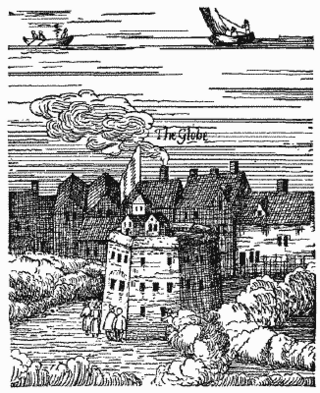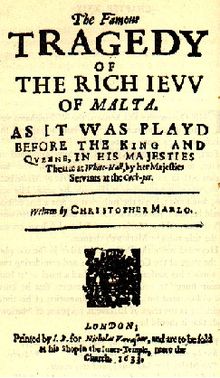
Christopher Marlowe, also known as Kit Marlowe, was an English playwright, poet, and translator of the Elizabethan era. Marlowe is among the most famous of the Elizabethan playwrights. Based upon the "many imitations" of his play Tamburlaine, modern scholars consider him to have been the foremost dramatist in London in the years just before his mysterious early death. Some scholars also believe that he greatly influenced William Shakespeare, who was baptised in the same year as Marlowe and later succeeded him as the preeminent Elizabethan playwright. Marlowe was the first to achieve critical reputation for his use of blank verse, which became the standard for the era. His plays are distinguished by their overreaching protagonists. Themes found within Marlowe's literary works have been noted as humanistic with realistic emotions, which some scholars find difficult to reconcile with Marlowe's "anti-intellectualism" and his catering to the prurient tastes of his Elizabethan audiences for generous displays of extreme physical violence, cruelty, and bloodshed.

The Merchant of Venice is a play by William Shakespeare, believed to have been written between 1596 and 1598. A merchant in Venice named Antonio defaults on a large loan taken out on behalf of his dear friend, Bassanio, and provided by a Jewish moneylender, Shylock, with seemingly inevitable fatal consequences.
Thomas Kyd was an English playwright, the author of The Spanish Tragedy, and one of the most important figures in the development of Elizabethan drama.
This article contains information about the literary events and publications of 1594.
Philip Henslowe was an Elizabethan theatrical entrepreneur and impresario. Henslowe's modern reputation rests on the survival of his diary, a primary source for information about the theatrical world of Renaissance London.

The Rose was an Elizabethan theatre. It was the fourth of the public theatres to be built, after The Theatre (1576), the Curtain (1577), and the theatre at Newington Butts – and the first of several playhouses to be situated in Bankside, Southwark, in a liberty outside the jurisdiction of the City of London's civic authorities. Its remains were excavated by archaeologists in 1989 and are listed by Historic England as a Scheduled Monument.

David Martin Bevington was an American literary scholar. He was the Phyllis Fay Horton Distinguished Service Professor Emeritus in the Humanities and in English Language & Literature, Comparative Literature, and the college at the University of Chicago, where he taught since 1967, as well as chair of Theatre and Performance Studies. "One of the most learned and devoted of Shakespeareans," so called by Harold Bloom, he specialized in British drama of the Renaissance, and edited and introduced the complete works of William Shakespeare in both the 29-volume, Bantam Classics paperback editions and the single-volume Longman edition. After accomplishing this feat, Bevington was often cited as the only living scholar to have personally edited Shakespeare's complete corpus.

Tamburlaine the Great is a play in two parts by Christopher Marlowe. It is loosely based on the life of the Central Asian emperor Timur. Written in 1587 or 1588, the play is a milestone in Elizabethan public drama; it marks a turning away from the clumsy language and loose plotting of the earlier Tudor dramatists, and a new interest in fresh and vivid language, memorable action, and intellectual complexity. Along with Thomas Kyd's The Spanish Tragedy, it may be considered the first popular success of London's public stage.
The Admiral's Men was a playing company or troupe of actors in the Elizabethan and Stuart eras. It is generally considered the second most important acting troupe of English Renaissance theatre.

Roderigo Lopes served as a physician-in-chief to Queen Elizabeth I of England from 1581 until his death by execution, having been found guilty of plotting to poison her. A Portuguese converso or New Christian of Jewish ancestry, he is the only royal doctor in English history to have been executed, and may have inspired the character of Shylock in Shakespeare's The Merchant of Venice, which was written within four years of his death.
The Earl of Pembroke's Men was an Elizabethan era playing company, or troupe of actors, in English Renaissance theatre. They functioned under the patronage of Henry Herbert, 2nd Earl of Pembroke. Early and equivocal mentions of a Pembroke's company reach as far back as 1575; but the company is known for certain to have been in existence in 1592. In that year, a share in the company was valued at £80.
The Newington Butts Theatre was one of the earliest Elizabethan theatres, possibly predating even The Theatre of 1576 and the Curtain Theatre, which are usually regarded as the first playhouses built around London. William Ingram believes it was probably the first of the three to begin construction, and may have been the first completed.

When You See Me You Know Me is an early Jacobean history play about Henry VIII, written by Samuel Rowley and first published in 1605.
Richard Perkins was a prominent early seventeenth-century actor, most famous for his performance in the role of Barabas in Christopher Marlowe's The Jew of Malta. At the peak of his career in the 1630s, many contemporaries judged Perkins to be the premier tragedian of his generation.
The Three Ladies of London is an Elizabethan comedy about usury that was probably first performed in 1581; it was published in a quarto edition in both 1584 and 1592. The play is unusual and noteworthy as a philo-Semitic response to the prevailing anti-Semitism of Elizabethan drama and in contemporaneous English society more generally.
The Earl of Sussex's Men was a playing company or troupe of actors in Elizabethan and Jacobean England, most notable for their connection with the early career of William Shakespeare.
Stereotypes of Jews in literature have evolved over the centuries. According to Louis Harap, nearly all European writers prior to the twentieth century projected the Jewish stereotypes in their works. Harap cites Gotthold Lessing's Nathan the Wise (1779) as the first time that Jews were portrayed in the arts as "human beings, with human possibilities and characteristics." Harap writes that, the persistence of the Jewish stereotype over the centuries suggests to some that "the treatment of the Jew in literature was completely static and was essentially unaffected by the changes in the Jewish situation in society as that society itself changed." He contrasts the opposing views presented in the two most comprehensive studies of the Jew in English literature, one by Montagu Frank Modder and the other by Edgar Rosenberg. Modder asserts that writers invariably "reflect the attitude of contemporary society in their presentation of the Jewish character, and that the portrayal changes with the economic and social changes of each decade." In opposition to Modder's "historical rationale", Rosenberg warns that such a perspective "is apt to slight the massive durability of a stereotype". Harap suggests that the recurrence of the Jewish stereotype in literature is itself one indicator of the continued presence of anti-Semitism among the readers of that literature.

Mortimer His Fall is an unfinished history play by Ben Jonson, about the overthrow of Roger Mortimer, 1st Earl of March, who had become de facto ruler of England in 1327 with Isabella of France after deposing and murdering Isabella's husband Edward II of England.

Shylock is a fictional character in William Shakespeare's play The Merchant of Venice. A Venetian Jewish moneylender, Shylock is the play's principal villain. His defeat and conversion to Christianity form the climax of the story.

A Knack to Know a Knave is a 1592 play closely associated with the principal performers Edward Alleyn and William Kempe. The play is a comic morality tale designed to highlight the talents of the celebrated clown Kempe, and is known from one text, itself arguably a memorial reconstruction. The author is unknown, though the involvement of Robert Greene has been suggested, as well as George Peele and Thomas Nashe. Recent scholarship has argued for a Shakespearean connection. On the basis of traditional literary-critical analysis and digital textual methods, Darren Freebury-Jones has proposed that the case for Robert Wilson's authorship of A Knack to Know a Knave is compelling. The play gives an insight into the nature of Elizabethan theatre during Shakespeare's time and the relationship between playscript and extemporised comedy.











